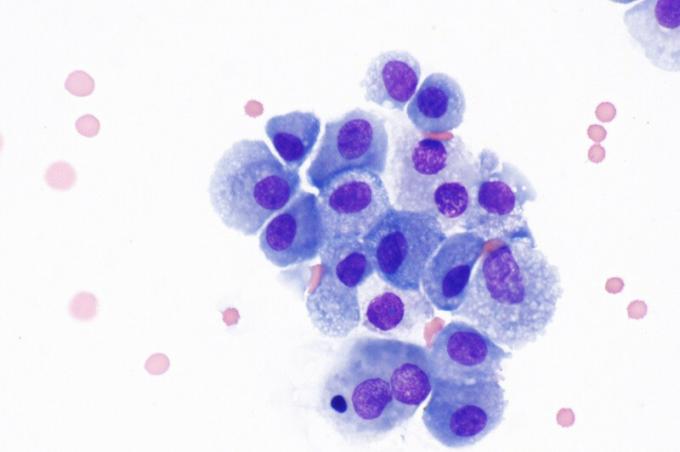Macrophages: what they are, characteristics and functions
The immune system enables the life of anatomically complex living beings on the planet. All animals are open systems, since we require the input of energy in the form of matter organic, oxygen in the air and an infinity of nutrients to develop our functions metabolic.
For all these reasons, the digestive and respiratory systems are exposed to the outside, since they communicate directly with the environment through the nostrils and the mouth, respectively.
These pathways for the entry of gases and matter are a free trail for thousands of viruses, bacteria, protozoa and helminths, which They establish in the mucous membranes of the tracts and, sometimes, travel through the circulatory system and invade the interior of the cells. To prevent the certain death of the host in the face of a pathogenic infestation, the immune system acts with various biological barriers.
From the skin to the lymphocytes, there are a series of mechanisms that prevent the proliferation of microorganisms in our body, in one way or another. The primary barriers (skin, mucous membranes, saliva, sweat and cough) prevent the entry of pathogens, but when these are established for any reason, a series of cell bodies belonging to the "innate immune system" come into action, which work in a general and rapid way against the invasions.
Macrophages are one of the most important cell bodies in this process, and here we tell you everything about them.- Related article: "Immune system: what it is, parts, functions and characteristics"
What are macrophages?
macrophages are cell bodies of an immune nature that are derived from monocytes in the blood, which in turn are produced in the bone marrow by specialized precursors. It should be noted that, unlike other circulating elements, these cells have a polymorphism quite marked, since they are spherical, ovoid and polygonal in shape, with 12-15 microns in diameter. overall diameter. They also have a nearly empty, ovoid nucleus with very little chromatin.
Originating from monocytes, macrophages leave the circulation to establish and differentiate into different tissues. These cell bodies are found in virtually all areas of the body, and its main function is to phagocytose and digest any biological agent that is interpreted as dangerous or alien to the body. In addition, it should be noted that there are several types depending on their location:
- Alveolar macrophage: as its name suggests, it is located in the pulmonary alveoli. Together, these cell bodies are responsible for the defense of the lower airways.
- Kupffer cells: responsible for the immune response and tissue modulation in the liver.
- microglia: located in the central nervous system. It removes old or dead neurons and exerts control over immunity in the nervous system.
- Spleen macrophages: they are responsible for removing old or dysfunctional red blood cells. This is extremely important, as it allows blood renewal.
Functions
As you can see, macrophages destroy pathogens, but also cells of the body itself that are useless or too old. Below, we explore some of the general functionalities of macrophages and their most striking features. Do not miss it.
1. Phagocytosis
As its name indicates (macro, large and phage, eat, "large eater"), the main function of macrophages is phagocytize all foreign bodies that enter the body, such as bacteria and waste substances metabolic.
Neutrophils (the most abundant white blood cells in the circulatory system, representing 70% of the total) are the first to arrive at the source of infection, but their useful life is very short, from a few hours to a couple of days a lot. The presence of neutrophils as the first internal defense barrier stimulates macrophages, which will go to the site of action and they will start by phagocytizing the dead neutrophils themselves.
Once they have encountered the pathogen, the macrophage surrounds it with a phagosome or endocytic vesicle, a vacuole formed around a particle assimilated by phagocytosis, which then fuses with an internalized lysosome in the phagocytic cell, giving rise to a "phagolysosome". Finally, various enzymes and toxic peroxides act on the microorganism enclosed in the phagolysosome and destroy it.
- You may be interested: "Leukocytes: what they are, types and functions in the human body"
2. Activation of the immune system
The macrophage destroys the localized threat in the specific tissue, but its function does not end here. The metabolic remains produced by the digestion of the microorganism are exposed in specific parts of the cell membrane of the phagocyte, which allows identification of the threat by helper T cells.
We are not going to focus on complex immune cascades, since it is enough for us to know that the recognition and multiplication of lymphocytes promotes the circulation of immunoglobulins (or antibodies). These antibodies recognize antigens on the surface of living microorganisms and adhere to them, acting as clear signals of threat. Thus, the rest of the macrophages know who to attack accurately and other cell bodies start to stop the infective event.
The immune system is supposed to be divided into two branches: “innate” and “acquired”. Macrophages are part of the innate mechanisms, but as you can see, the acquired immune system could not exist without them. This leads us to draw two very clear conclusions:
- The innate immune system (particularly macrophages and neutrophils) activate the acquired immune system in response to infection.
- The acquired immune system uses the mechanisms of innate immunity to act. This means that once the antibodies have been produced and the lymphocytes stimulated, the macrophages continue to attack the threat.

3. tissue repair
Beyond the ingestion of foreign compounds, macrophages also play an essential role in wound healing and tissue regeneration.
When an injury occurs, platelets are among the first circulating structures to reach the open area, since its function is to induce coagulation as quickly as possible, in order to maintain homeostasis internal.
Attracted by platelet growth factors, monocytes come through the bloodstream to the wound, with the help of the walls of the vessels and fine capillaries.
These rapidly mature into macrophages, whose function is keep at bay any bacteria or pathogens that try to enter through the bleeding opening to the medium. They are also responsible for getting rid of dead tissue (through the release of proteases), which "makes room" for rapid and effective tissue regeneration.
- You may be interested: "Main Cell Types of the Human Body"
Macrophages and cancer: a double-edged sword
As it could not be otherwise, we must dedicate a few last lines to the role of these immune cells in the development of malignant neoplasms, since cancer is one of the most serious health problems worldwide in the present.
Unfortunately, the information is mixed in this area, and much less positive than one might expect. According to studies such as "Macrophage diversity enhances tumor progression and metastasis," published in the journal Cell, macrophages can promote and accelerate the growth and metastasis of cancer cells, contrary to what might be expected. The inflammatory events that they cause in the initial stages promote cell mutation to malignant strains, but in addition, they also stimulate the migration and proliferation of already cancerous cells, even inhibiting the mechanisms antitumor.
We go even further, because the high number of macrophages in a tumor is positively correlated with a worse prognosis in many types of cancer, such as breast, cervical, brain or prostatic. Although not all the mechanisms that promote this highly problematic symbiosis are yet understood, this reality undoubtedly puts into perspective that, sometimes the human body kills itself without the help of exogenous factors.
Summary
As we have seen, macrophages are essential cells for the immune response both innate and acquired, as well as to repair tissues and maintain hemostasis, among many others stuff. In addition, its study and characterization could help us to understand better and better why the malignant tumors, since there seems to be a clear relationship between macrophages and cells carcinogenic.
The future of cancer therapy is promising, since the current intention is to use these macrophages as authentic "Trojan horses". Due to their relationship with tumor cells, they could serve as reservoirs for anti-cancer drugs, even as an object of study to develop targeted anti-tumor therapies.



